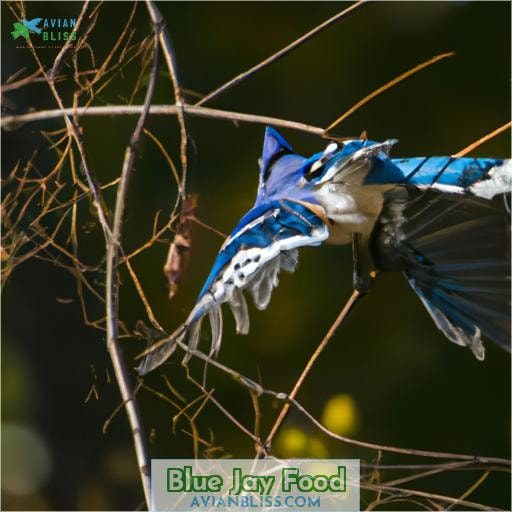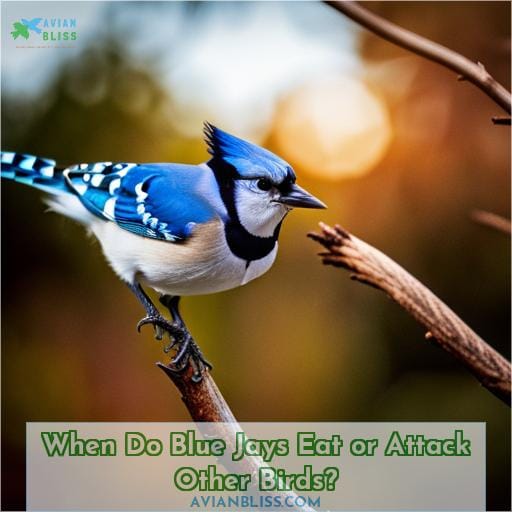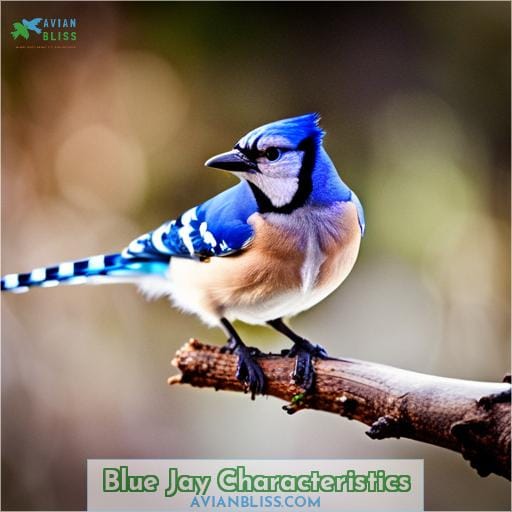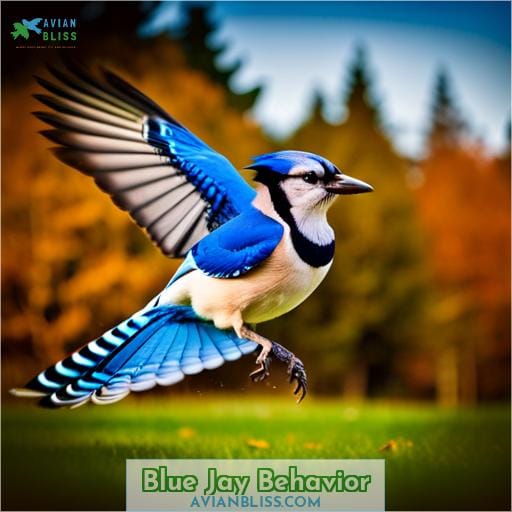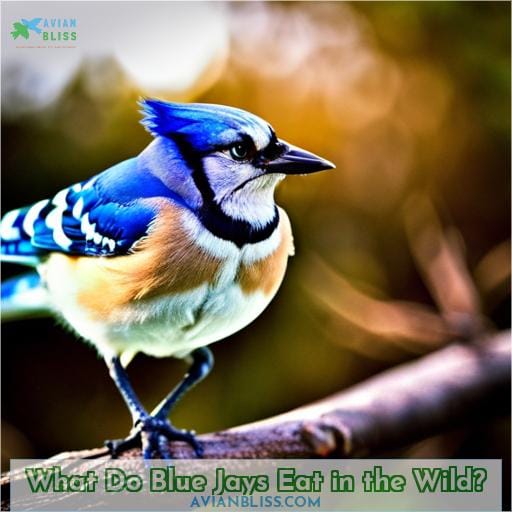This site is supported by our readers. We may earn a commission, at no cost to you, if you purchase through links.
 Greetings fellow bird enthusiast! Have you ever wondered if blue jays feast on other birds? I know I sure have. These flashy jays get a bad rap for being aggressive bullies, but the reality is they rarely kill and eat other birds.
Greetings fellow bird enthusiast! Have you ever wondered if blue jays feast on other birds? I know I sure have. These flashy jays get a bad rap for being aggressive bullies, but the reality is they rarely kill and eat other birds.
However, on occasion, they will prey on eggs or fledglings of smaller songbirds. While blue jays are intelligent and social birds, they can be quite territorial and mob predators, behavior that may have led to assumptions they eat other birds.
Stick with me as we separate fact from fiction about the behavior and eating habits of these misunderstood backyard birds. I think you’ll find blue jays have more to admire than fear if we simply take the time to understand them.
Table Of Contents
- Key Takeaways
- Do Blue Jays Eat Other Birds?
- Blue Jay Food
- When Do Blue Jays Eat or Attack Other Birds?
- Are Blue Jays Aggressive Toward Humans?
- Can Blue Jays Attack Their Fellow Blue Jays?
- Blue Jay Characteristics
- Blue Jay Behavior
- Facts About Blue Jays
- What Do Blue Jays Eat in the Wild?
- How Do Blue Jays Hunt?
- Frequently Asked Questions (FAQs)
- Conclusion
Key Takeaways
- Blue jays have a diet that is composed of less than 1% of other birds’ eggs or fledglings.
- Blue jays primarily feed on insects and plant matter, with seeds, fruits, nuts, and berries making up around 75% of their food intake.
- Blue jays play a crucial role in ecosystems by spreading seeds and protecting smaller birds through mobbing behavior.
- Nest predation by blue jays is rare and is typically a last resort during acute food shortages.
Do Blue Jays Eat Other Birds?

You’d find watching that loud blue bully snatch helpless hatchlings quite disturbing. Yet the truth is more nuanced. While aggressive and territorial, blue jays rarely resort to eating other birds. Their adaptability enables them to thrive in diverse habitats. Though climate impacts alter ecosystems, these clever birds adjust.
Their habit of caching seeds aids recovery from habitat loss. Despite mobbing smaller birds, blue jays boost security. With keen eyes, their alarm calls warn of predators. While their nesting tendencies seem violent, fierce protection of offspring is common among species.
To support blue jays, offer suet and peanuts. Understanding precise feeding habits and bird behavior promotes coexistence. See past assumptions. Embrace interdependence. With compassion, even a notorious bully becomes a fellow creature deserving dignity.
Blue Jay Food
Bird lover, blue jays are well-known for their varied diet. The majority consists of plant matter like acorns, seeds, fruits, and suet, while around a fifth is made up of insects, small invertebrates, and occasionally scraps of meat.
Plant Matter (75% of Diet)
About 75% of a blue jay’s diet is plant matter. You probably love finding sunflower seeds, peanuts, and acorns in your yard. Seeds, fruits, nuts, and berries are essential energy sources. Tree-dwelling enhances navigation and caching skills for locating buried nuts.
Young jays start with soft insects and larvae before graduating to harder plant foods.
Insects (22% of Diet)
Around dusk, jays greedily swoop down and completely ravage massive swarms of buzzing bugs like a plague upon the land. They hunt cicadas frequently. Loudly mobbing crows, jays mobilize insects omnivorously.
Treetop-nesting, these monogamous corvids feast upon wild foraged foods. Foraging behaviors diversify blue jay diets while partnered.
Nuts and Seeds
You’ll find blue jays going nuts for seeds when insects get scarce.
Blue jays adapt their diets seasonally to take advantage of nature’s bounty. In autumn, they gorge on acorns and other nuts to fatten up for winter. These intelligent birds cache nuts and seeds to provide sustenance through cold months when insects are scarce.
Their versatile beaks allow them to crack hard shells and access the nutrient-rich meat inside.
Watch jays flock to your feeders when you offer sunflower seeds, peanuts, and other high-fat foods. With opportunistic omnivore habits, blue jays thrive by exploiting diverse food sources in their range.
| Food Type | Examples | Seasonal Notes |
|---|---|---|
| Nuts and Seeds | acorns, sunflower seeds, peanuts | caching peaks in fall; sustains through winter |
| Insects and Larvae | beetles, caterpillars, cicadas | spring through summer |
| Fruits and Berries | wild cherries, dogwood, sumac | summer and fall |
Small Fruits
You can visualize plump berries glistening as they’re plucked. Small fruits are prized by blue jays, not only for immediate consumption but also for strategic storage. These clever birds gather fruits, skillfully navigating the foliage, enhancing their diet diversity.
The vibrant spectrum of blues and blacks gives them a striking appearance, amplified when their crests signal moods and interactions. While blue jays exhibit aggression towards humans if threatened, their role in ecosystems remains essential.
Through fruit caching and consumption, they hold the power to shape the landscape and foster a sense of liberation in the interconnected web of nature.
Suet and Meat Scraps
Engaging backyard observers, picture this: amidst your garden’s offerings, a feast unfolds as blue jays partake in a protein-rich delight, relishing suet and meat scraps—a gourmet selection showcasing their diverse palate.
Amid winter’s scarcity, these aviators maintain their false perception of nest protection through communication and aggressive behavior, while foraging insects and adapting their diet.
When Do Blue Jays Eat or Attack Other Birds?
In the realm of avian interactions, moments arise when feathery beings of the sky, driven by territorial instincts, cross paths in a display of nature’s intensity and purpose. Blue jays, recognized for their distinctive behaviors, play a multifaceted role in the intricate tapestry of avian dynamics.
While their diet predominantly comprises plants and insects, occasional instances of feeding on other birds do occur. However, studies indicate that such interactions are relatively rare, with only about 1% of blue jays partaking in such behaviors.
Their territorial nature and aggressive tendencies often lead to misconceptions about their diet. Engaged in social complexity, blue jays engage in mobbing behaviors against predators and compete for resources, further adding to their intricate narrative.
Nesting interactions reveal more about these intelligent birds. While they may rarely consume other birds’ eggs or fledglings as a last resort during scarcity, their primary focus remains on their varied diet.
The blue jay’s presence is woven into ecosystems as both a forager and protector. Their role extends beyond mere survival; they actively aid in seed dispersal and provide a haven for smaller birds through their vigilant presence.
Understanding these feeding dynamics, behavioral triggers, and nesting interactions enriches our comprehension of their role within ecosystems, unraveling a story of social intricacy and ecological symbiosis.
Are Blue Jays Aggressive Toward Humans?
With a distinctive demeanor, these vibrant creatures occasionally display their assertive side, not shying away from expressing their feelings even when encountering fellow inhabitants of their environment.
Blue jays, known for their territorial behavior and vocal prowess, can exhibit a measure of aggression towards humans, particularly when they feel threatened or cornered.
Their vocal mimicry, which includes imitating the calls of other birds and even the Red-shouldered Hawk, serves as a communication signal during various interactions, conveying their emotions and intentions.
During mating season, this assertiveness intensifies as blue jays fiercely defend their territories and compete for mates. While their aggression is primarily directed at perceived threats and rivals, it’s important to note that blue jays rarely target humans unprovoked.
Understanding their behavior during nesting periods, where they can resort to defensive actions against potential threats to their nests, provides valuable insight into their complex interactions with the world around them.
In essence, the blue jays’ assertive behavior, vocal mimicry, and occasional confrontations with humans highlight their intricate communication strategies and instinctual drive to protect their territory and kin.
This multifaceted behavior not only underscores their role in the ecosystem but also offers a glimpse into the intricate dynamics of avian social interactions.
Can Blue Jays Attack Their Fellow Blue Jays?
Sure thing! Turning attention to their interactions, these birds might not always get along, occasionally showing their aggressive side even towards their own kind. Blue jays are known for their territorial behavior, and this territoriality can lead to conflicts among individuals.
Territorial Disputes: Blue jays are fiercely territorial creatures, especially during the breeding season. Competing for limited resources like food and nesting sites can escalate into clashes between neighboring jays.
Crest Behavior: The position of a blue jay’s crest can indicate its mood. When the crest is lowered, it generally indicates a safe and calm demeanor. However, during moments of aggression, like territorial disputes, the crest is raised, signifying a bold and assertive stance.
Nest Rivalry: Nesting sites are valuable real estate in the world of blue jays. Conflicts can arise when neighboring pairs of blue jays vie for the best nesting spots. These disputes can sometimes lead to intense aerial battles and vocal disputes.
Intra-species Aggression: While blue jays might attack other bird species occasionally, they also exhibit aggressive behavior toward their own species. This aggression can be seen in territorial disputes, food competition, and jostling for dominance within a group.
Blue jays’ complex social interactions and territorial behaviors add a layer of intrigue to their already captivating nature. These behaviors, though driven by survival instincts, showcase the delicate balance between cooperation and competition in the avian world.
Blue Jay Characteristics
Sure, here’s the introduction paragraph discussing the subtopic of Crest and Feather Color, Intelligent and Mimicking Behavior:
Amidst the intricate tapestry of avian diversity, the blue jay stands distinct with its signature characteristics that belie deeper insights into its behavior and communication. With its prominent crest and vibrant feather palette of blue and black, the blue jay captures attention as a harbinger of both elegance and intensity.
Yet, beyond its aesthetic allure, this species reveals a remarkable cognitive acumen. It demonstrates an ability to mimic sounds, echoing the calls of fellow birds and thereby weaving a symphony that echoes the intricacies of the ecosystem it inhabits.
Crest and Feather Color
Picture the vibrant crest of these intelligent avian creatures as a mood indicator, its rise signifying heightened aggression, setting a dramatic stage for their interactions. Blue jays’ feather color variations, particularly their striking blue hue, are a result of light reflection, not true pigmentation.
Melanin, responsible for brown pigments, contributes to their distinct patterns. These nuances serve as communication signals, expressing emotional states beyond their raucous calls. The crest’s position, whether defiantly raised or cautiously lowered, unveils their intricate language, showcasing their remarkable capacity for conveying power, understanding, and liberation in the avian realm.
Intelligent and Mimicking Behavior
Immerse yourself in the world of these clever creatures, watching in fascination as they effortlessly replicate the calls and sounds of fellow inhabitants of the woods and skies. Blue jays, with their remarkable mimicry insights, showcase an astonishing vocal repertoire that goes beyond their iconic squawks.
Their cognitive imitation abilities are a testament to their communication skills, as they flawlessly mimic the variety of sounds around them. From the delicate melodies of songbirds to the authoritative calls of hawks, blue jays masterfully incorporate these echoes into their own language, revealing a profound understanding of their sonic environment.
Blue Jay Behavior
Delving into the intricate tapestry of avian behavior, you’ll find blue jays to be no strangers to the art of territoriality and strategic defense. Their ceaseless vigilance against potential threats often leads to the mesmerizing spectacle of mobbing predators.
This display unites fellow feathered beings in a collective effort to ward off danger.
Moreover, while the notion of nest predation might conjure images of opportunistic depredation, it’s noteworthy that among blue jays, such a recourse remains a rare occurrence. It is typically resorted to only under the shadow of food scarcity, reinforcing the profound interconnectedness of their behavior within the mosaic of their ecosystem.
Territorial and Mobbing Predators
Witness their fierce nature as they fiercely guard their territories, uniting in a bold stand against threats, demonstrating a communal strength that commands respect.
Few who have seen a mob of blue jays harassing a hawk can’t doubt their ferocity when defending nests.
While their aggression seems to target other birds, studies show little evidence of frequent nest predation or eating habits focused on other birds.
Their hunting techniques and eating habits reveal an omnivorous bird misunderstood due to territorial displays.
Nest Predation (Rare)
You’d be surprised how rarely blue jays actually eat other birds’ young. As intelligent and aggressive as they seem, nest predation remains an uncommon last resort for them during acute food shortages.
Much rarer than the mobbing you witness, raiding nests takes tremendous energy compared to foraging. Remember, less than 1% of jays’ stomach contents show evidence of other birds. Focus instead on providing habitat and supplemental feeding as a powerful alternative to their territorial behavior.
Promoting stable ecosystems can curb the desperation that drives their opportunistic preying.
Facts About Blue Jays
You’re fascinated by the varied behavior and characteristics of these striking blue birds. Though blue jays occasionally consume eggs or nestlings, extensive research shows this is rare, estimated at only 1% of their diet.
Their mischievous reputation stems more from aggressive territorial displays, not active predation.
In truth, blue jays play a vital role in ecosystems through spreading seeds and even protecting smaller birds by mobbing predators. Their complex behaviors reflect high intelligence, from mimicking hawk calls to using tools.
Blue jays face threats like habitat loss, pesticide impacts, and urbanization effects. Supporting these adaptable birds means protecting native vegetation, reducing pesticides, and providing habitat in urban areas.
As their bright blue forms wing through the trees, we must ensure these clever characters remain a part of the natural spectacle.
What Do Blue Jays Eat in the Wild?
You’ll notice blue jays have a varied diet that shifts seasonally between more insects in summer and increased plant matter like acorns in winter when insects are scarce; their omnivorous behavior allows them to adapt to changes in food availability throughout the year.
Seasonal Shifts in Diet
Your backyard birds shift from eating more insects in summer to dining on cached nuts and seeds come winter. As seasons change, so do the food sources available to opportunistic birds like blue jays.
Summer brings an abundance of protein-rich insects, allowing blue jays to catch dragonflies, beetles, and cicadas on the wing.
Fortunately, blue jays adapt to seasonal scarcity through their habit of caching acorns and other nuts in tree crevices and soil. This forward-thinking behavior ensures sustenance during lean winter months when insects hide themselves away.
With proper habitat and food sources, blue jays and other wildlife can flourish across the seasons.
Insects and Plant Matter
In the heat of summer, cicadas’ song fills the air as you snatch insects from the sky. The warm months bring an abundance of juicy insects like cicadas, grasshoppers, crickets, and dragonflies to fuel your high-energy lifestyle.
As an omnivore, your varied diet provides balanced nutrition through seasonal shifts. Your foraging skills allow you to be selective, seeking energy-dense sources like acorns in autumn to cache for winter.
By spreading seeds and alerting smaller birds of predators, you play a vital role in maintaining ecosystem balance.
How Do Blue Jays Hunt?
Their pursuit is impressive and hints at intellect. Blue jays are crafty hunters that use a variety of strategies to catch their prey.
- They scan treetops and dive bomb insects like cicadas and dragonflies mid-flight.
- Blue jays swoop down on unsuspecting rodents and baby birds when the opportunity arises.
- During breeding season, they aggressively defend their territory against other birds and raid nests for eggs and hatchlings.
Shifts in food availability lead blue jays to alter their hunting habits seasonally. In summer, they feast on abundant insects and larvae. Come winter, their pursuit redirects towards hoarded nuts and seeds.
Throughout the year, blue jays continuously hone their skills, allowing them to thrive across diverse North American ecosystems.
Frequently Asked Questions (FAQs)
How long do blue jays live?
Having lived 6-9 years on average, blue jays thrive across North America. You’ll spot their intelligence and vibrant colors as long as tree-lined habitats persist. Though predators lurk, their survival astounds if you heed lessons from avian elders.
What time of day are blue jays most active?
Your blue jays are most active at dawn and dusk, foraging busily for insects and seeds to fuel their busy days. They’ll sing their morning songs as the sun peeks over the horizon, then flit between bushes seeking breakfast before settling in the trees to preen and socialize when the day warms up.
Watch closely at sunset to spot their return to feed and roost as the light fades.
How do you attract blue jays to a bird feeder?
Place sunflower seeds in a feeder. Blue jays love them. Also, try shelled peanuts. Avoid mixes with filler seeds. Position feeders in open spots. Blue jays are wary, so give them good visibility.
What sounds and calls do blue jays make?
Friend, blue jays have quite the vocal repertoire! Their loud, harsh jay! jay! calls ring through the forests as they fiercely defend territories. Mimicking hawks, cawing crows, meowing cats – their vocal mimicry knows no bounds.
Perched high in the trees, these clever birds enchant us with their raucous songs and calls, echoing the wild spirit within.
Do blue jays migrate or stay in one area year-round?
You, my friend, don’t bother fretting whether blue jays migrate or not. These clever birds will stick around to pester and delight you all year long, their brash voices piercing the skies as they cache acorns or mob hawks.
Though their rollicking antics often raise hackles, take heart that they spread seeds and ward off smaller birds from harm.
Conclusion
Many are quick to judge the blue jay as a ruthless killer, yet the facts reveal that they are not innate predators of their feathered brethren. Though possessive of their territory, less than 1% have another bird on their menu.
They favor nuts, seeds, fruits, and insects; fellow avians are an afterthought. While their reputation precedes them, viewing their behavior through an ecological lens unveils an integral role. There remains far more to uncover about the mysteries of the blue jay; endless fascination awaits.

